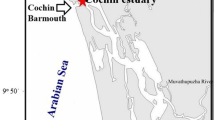Abstract
In a monsoon-affected tropical estuary, oscillations in freshwater discharge during monsoon shifted the phytoplankton blooms from those adapted to low salinities to high salinities and vice versa. Salinity stratification during monsoon (onset and restart after an intermittent break) favored diatom (Skeletonema) bloom in low-saline surface waters. In high-saline, nutrient-rich bottom waters, Fragilariopsis (diatom) bloom was observed during onset of monsoon and persisted till the end of monsoon. The break period in monsoon altered the phytoplankton community leading to mixed species bloom of large-sized diatoms and harmful dinoflagellates (Gymnodinium catenatum and Cochlodinium polykrikoides) under high-saline, nutrient-poor, non-stratified, and transparent water column. Such variations in community should be considered for better understanding the biogeochemistry of monsoon-influenced tropical estuaries. The dominance of Skeletonema is determined positively by the extent of low-saline stratified condition whereas most of the observed taxa were favored by high-saline, nutrient-poor, and transparent waters.
Similar content being viewed by others
References
Anderson, S. M., & Roels, O. A. (1981). Effects of light intensity on nitrate and nitrite uptake and excretion by Chaetoceros curvisetus. Marine Biology, 62, 257–262.
Benson, B. B., & Krause, D. Jr (1984). The concentration and isotopic fractionation of oxygen dissolved in freshwater and seawater in equilibrium with the atmosphere. Limnology and Oceanography, 29, 620–632.
Bhat, S. R., & Matondkar, S. G. P. (2004). Algal blooms in the seas around India—Networking for research and outreach. Current Science, 87, 1079–1083.
Bhattathiri, P. M. A., Devassy, V. P., & Bhargava, R. M. S. (1976). Production at different trophic levels in the estuarine system of Goa. Indiana Journal of Marine Science, 5, 83–86.
Cloern, E. J. (1979). Phytoplankton ecology of the San Francisco Bay system: The status of our current understanding. San Francisco bay: the urbanized estuary. The Pacific Division of the American Association for the Advancement of Science c/c California Academy of Sciences. San Francisco, California 941 18, pp. 247–264.
Devassy, V. P., & Goes, J. I. (1988). Phytoplankton community structure and succession in a tropical estuarine complex (Central West coast of India). Estonian Coastal Shelf life Science, 27, 671–685.
D’Silva, M. S., Anil, A. C., & Borole, D. V. (2008). Tracking history of dinoflagellate distribution in Goa, west coast of India through 210Pb dating. International Conference on Biofouling and Ballast Water Management February 05–07, Goa, India, p 79.
Gopinathan, C. P. (1974). Seasonal abundance of phytoplankton in the Cochin backwaters. Journal of the Marine Biological Association of India, 14, 568–577.
Goswami, B. N., Venugopal, V., Sengupta, D., Madhusoodanan, M. S., & Xavier, P. K. (2006). Increasing trend of extreme rain events over India in a warming environment. Science, 314, 1442–1445.
Kiørbe, T., & Nielsen, T. G. (1994). Regulation of zooplankton biomass and production in a temperate, coastal ecosystem: Copepods. Limnology and Oceanography, 39, 493–507.
Kim, D. I., Matsuyama, Y., Nagasoe, S., Yamaguchi, M., Yoon, Y. H., Oshima, Y., et al. (2004). Effects of temperature, salinity and irradiance on the growth of the harmful red tide dinoflagellate Cochlodinium polykrikoides Margalef (Dinophyceae). Journal of Plankton Research, 26, 61–66
Krishna Kumari, L., Bhattathiri, P. M. A., Matondkar, S. G. P., & John, J. (2002). Primary productivity in Mandovi-Zuari estuaries in Goa. Journal of Marine Biological Association of India, 44, 1–13.
Nair, V. R. (1980). Production and associations of zooplankton in estuarine and nearshore waters of Goa. Indiana Journal of Marine Science, 9, 116–119.
Mitbavkar, S., & Anil, A. C. (2000). Diatom colonization on stainless steel panels in estuarine waters of Goa, west coast of India. Indiana Journal of Marine Science, 29, 273–276.
Mitbavkar, S., & Anil, A. C. (2002). Diatoms of the microphytobenthic community: Population structure in a tropical intertidal sand flat. Marine Biology, 140, 41–57.
Padmavati, G., & Goswami, S. C. (1996). Zooplankton ecology in the Mandovi-Zuari estuarine system of Goa, west coast of India. Indiana Journal of Marine Science, 25, 268–273.
Patil, J. S., & Anil, A. C. (2005). Biofilm diatom community structure: Influence of temporal and substratum variability. Biofouling, 21(3/4), 189–206.
Patil, J. S., & Anil, A. C. (2008). Temporal variation of diatom benthic propagules in a monsoon-influenced tropical estuary. Continental Shelf Research, 28, 2404–2416.
Qasim, S. Z., & SenGupta, R. (1981). Environmental characteristics of the Mandovi-Zuari estuarine system in Goa. Estonian Coastal Shelf life Science, 13, 557–578.
Shetye, S. R., Gouveia, A. D., Singbal, S. Y., Naik, C. G., Sundar, D., Michael, G. S., et al. (1995). Propagation of tides in the Mandovi-Zuari estuarine network. Proceedings of Industrial Academy of Sciences (Earth and Planetary Science), 104, 667–682.
Smetacek, V. S. (1985). Role of sinking in diatom life history cycles: Ecological, evolutionary, and geological significance. Marine Biology Letters, 84, 239–251.
Subrahmanyan, R. (1946). A systematic account of the marine plankton diatoms of the Madras coast. Proceedings of Indian Academy of Science, 24, 85–197.
Subrahmanyan, R. (1959). Studies on the phytoplankton of the west coast of India. Parts I and II. Proceedings of the Indian Academy of Sciences, 50B, 113–187.
Tomas, C. R. (1997). Identifying marine phytoplankton (pp. 5–858). New York: Academic Press.
Unnikrishnan, A. S., Shetye, S. R., & Gouveia, A. D. (1997). Tidal propagation in the Mandovi-Zuari estuarine network, west coast of India: Impact of freshwater influx. Estonian Coastal Shelf life Science, 45, 737–774.
Author information
Authors and Affiliations
Corresponding author
Rights and permissions
About this article
Cite this article
Patil, J.S., Anil, A.C. Variations in phytoplankton community in a monsoon-influenced tropical estuary. Environ Monit Assess 182, 291–300 (2011). https://doi.org/10.1007/s10661-011-1876-2
Received:
Accepted:
Published:
Issue Date:
DOI: https://doi.org/10.1007/s10661-011-1876-2




